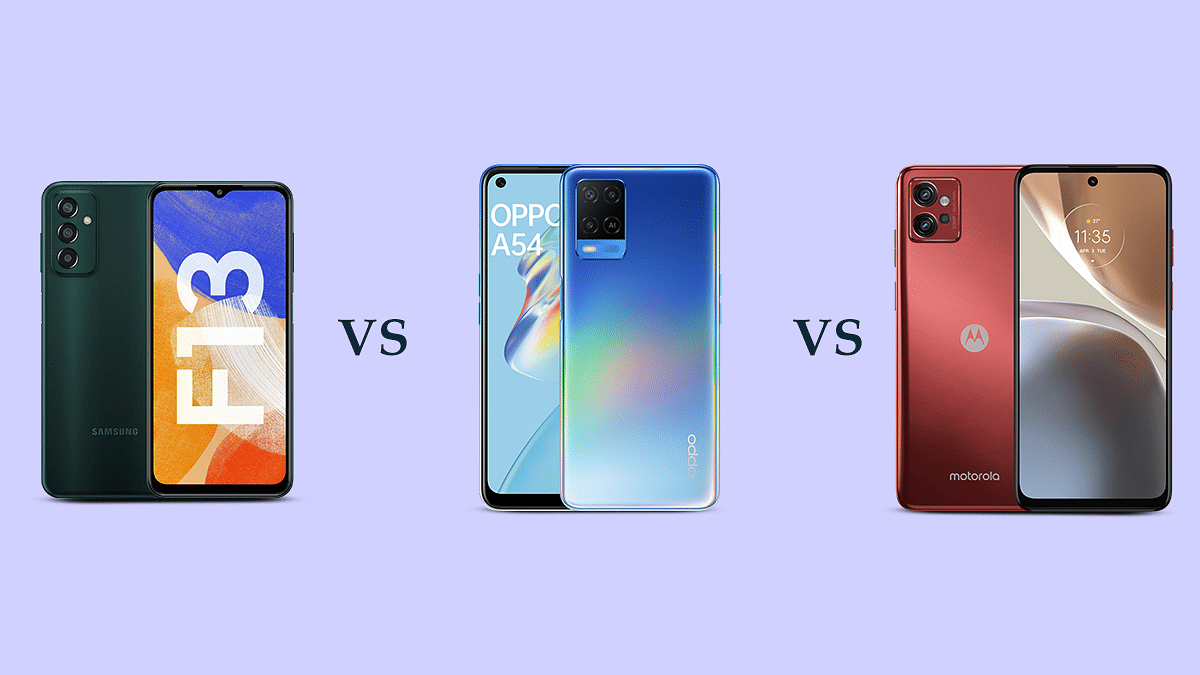The most recent model in the company’s F-series lineup is the Samsung Galaxy F13. According to Samsung, this sub-Rs 12,000 phone meets the changing demands of Gen Z and millennials. The OPPO A54, a smartphone with a focus on affordability from the Chinese smartphone juggernaut OPPO, was recently revealed in India. The phone, which has a starting price of Rs 13,990, competes in a congested mobile market that is dominated by brands like Realme and Xiaomi. The Moto G32, a low-cost smartphone from Motorola, was unveiled in the middle of this year’s summer. It is the immediate replacement for the Motorola Moto G31, which was unveiled at the very end of the previous year. Let’s examine how these phones perform as a daily driver in this in-depth study.
Design and Camera
The Samsung Galaxy F13 has a 6.6-inch PLS LCD screen with a 20:9 aspect ratio, a 400ppi pixel density, and a 1080 x 2408 resolution. A front camera lens is housed in a waterdrop notch on the smartphone’s bezel-free display. The Samsung Galaxy F13’s back is equipped with a 50MP f/1.8 Wide Angle Lens, a 5MP f/2.2 Ultra-Wide Angle Lens, and a 2MP f/2.4 Depth Lens. The primary features of this camera configuration are Face Detection, Digital Zoom, Autofocus, Auto Flash, and HDR mode. On the front is a single 8MP f/2.2 Wide Angle Camera.
The display on the 6.51-inch OPPO A54 has a punch hole in it and is bezel-less. In addition to having a 270ppi pixel density, the smartphone’s IPS LCD has a 20:9 aspect ratio. Additionally, with a resolution of 720 x 1600 pixels and a refresh rate of 60Hz, OPPO provides a visually stunning experience. The smartphone has three cameras visible on its back: a 2MP f/2.4 macro camera, a 2MP f/2.4 depth camera, and a 13MP f/2.2 wide-angle main camera. LED flash, autofocus, ISO control, exposure compensation, HDR mode, continuous photography, auto flash, face identification, digital zoom, etc. are among the features displayed by the full camera setup. Additionally, a 16MP f/2.0 Wide Angle Primary Camera with AI enhancements is mounted on the front.
The 6.5-inch IPS LCD on the Moto G32 also has a punch-hole at the top. Furthermore, this display’s 1080 x 2400 resolution, 405ppi pixel density, and 90Hz refresh rate all contribute to its stunning graphics and fluid scrolling experience. On the back of the Moto G32, there is a three-lens camera setup. Along with a 50MP f/1.8 wide-angle camera, an 8MP f/2.2 ultra-wide angle lens, and a 2MP f/2.4 macro camera are also included. Autofocus, LED flash, and HDR mode Some of the built-in features are Face Detection, Exposure Compensation, and Continuous Shooting. There is a 16MP f/2.4 Selfie Camera on the front.
Configuration and Battery
The Galaxy F13 includes a 4GB RAM and Samsung Exynos 8 Octa 850 processor. A Mali-G52 GPU fulfils all of the computer’s graphic needs. It also has an Octa-core Cortex A55 processor, which can operate at a maximum speed of 2GHz. The huge 6000mAh Li-ion battery within the Samsung Galaxy F13 has a 15W Fast Charging compatibility.
The OPPO A54 is outfitted with a MediaTek Helio P35 chipset, a powerful 4GB of LPDDR4X RAM, and an Octa-core Cortex A53 engine running at 2.3GHz. A PowerVR GE8320 GPU handles all graphic-related needs. A strong Li-Polymer battery with a 5000mAh charge capacity is included with the smartphone. The cell is also capable of 18W Fast Charging.
The Moto G32’s internal Qualcomm Snapdragon 680 chipset enables customers to work continuously all day long. The Octa-core Dual Kryo 265 Processor Layout and 4GB RAM are also included with this chipset. The smartphone’s Adreno 610 produces stunning visuals. The Moto G32 has a Li-Polymer battery inside with a 5000mAh charging capacity. This non-removable battery is designed to work with a 33W Fast Charging system.
Storage and Connectivity
With the Samsung Galaxy F13, users receive 64GB of internal storage. Using a micro SD card, you can increase this storage by up to 1TB. The gadget has connectivity options such USB Type-C, Mobile Hotspot, Bluetooth v5.0, Wi-Fi, A-GPS with Glonass, and 4G VoLTE.
The 64GB internal storage of the OPPO A54 may be increased to 256GB using microSD cards. The smartphone offers 4G VoLTE networks, Bluetooth v5.0, Mobile Hotspot, Wi-Fi, A-GPS, Glonass, and USB Type-C as connectivity options.
The Moto G32 offers 64GB of internal storage that can be expanded by up to 1TB with a micro SD card. The Moto G32 comes with 4G VoLTE, Bluetooth v5.2, A-GPS with Glonass, USB Type-C, Wi-Fi, and Mobile Hotspot as connectivity choices.
GizNext’s Expert Opinion
The Samsung Galaxy F13 is a respectable smartphone that costs under Rs. 15,000. Its quad-camera setup and thorough battery profile are what really set it apart. But when it comes to storage, several manufacturers outperform this specific smartphone. A balanced option to choose is the OPPO A54. Excellent camera setups on both sides of the device are supported by a strong battery system and a tonne of storage. However, the device’s self-weight is a bit on the heavy side. You should consider purchasing the highly effective and dependable Moto G32 smartphone. The device has a potent CPU, 4GB of RAM, and a sizable battery to keep you going all day. Additionally, you can rely on the specific to make some practical captures in a variety of lighting situations.

